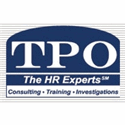In the last few months, TPO has experienced an increase in requests for recruitment assistance. Across the board, it appears that TPO members and clients are ramping up their recruitment efforts. From Agriculture, to Non Profits, to Education, organizations are once again hanging out the “NOW HIRING” signs. After some brief research, it appears that online job postings are up, one source saying that Q2 showed gains of 12% over the previous quarter.
So, perhaps, the light at the end of the economic tunnel is beginning to appear. If your organization is starting to think about adding staff, here are just a few TPO recruiting recommendations.
1. Get the job description right! Really think about what the actual “requirements” are for the position. For example, is it 100% necessary that the incumbent has a 4-year degree (which we would expect for Engineers, Accountants, Attorneys, etc.) or will a combination of education and experience be acceptable? Does the person really need to be a math whiz or will a calculator be readily available? Understand what is truly a “Must Have” to perform the job versus what is just on the “Wish List.”
2. Make sure you are targeting the appropriate audience. For example, if your position is administrative or customer service oriented, then Craigslist or local job boards might be the right place to post an ad. If you are looking for a higher level, more specific candidate, try LinkedIn or Association websites (example: SHRM for HR Professionals or Blueskysearch for produce related jobs). Don’t forget your current employees! They know the work environment and may be able to refer the perfect candidate for your open position. Employees generally won’t refer someone who isn’t going to “fit”, since it is their reputation on the line. Explore an Employee Referral Program to enlist their assistance.
3. Ask the right questions! The use of well-crafted behavioral based interview questions is helpful in finding a good match for the position. Think about what behaviors, skills, traits, etc. the “ideal” candidate should possess in your company’s environment and build questions around them. An inside sales person will likely need a different skill set than an outside sales person. Maybe the organization is a start up as opposed to a non-profit or government agency. There are a lot of differences between these work environments, hence different questions will be asked.
4. Use real life work assessments in the selection process. If the position requires an incumbent to have in depth knowledge of employment regulations, quiz candidates about them. If the position requires a bilingual/biliterate employee, ask candidates to write a memo addressing a certain issue in both English and Spanish. Ensure that these assessments/assignments are job related.
5. Sweat the small stuff! The way that a candidate responds to an ad can be highly useful in your selection. For example, we recently recruited a Communications & Electronic Media Manager. Candidates’ resume submissions disclosed a lot about their qualifications. One of the ways that a candidate could prove he/she was a qualified marketing professional was presentation of an eye appealing resume. Did they fully understand that different website technologies could alter their document and turn it into garbled, hard-to-read, undecipherable junk? Did they adjust to this knowledge by ensuring the format of their resume was presentable or allow the websites to alter it? Another way we assessed whether an applicant was qualified for the electronic media portion of the position was to see if they were “plugged in” to the latest technologies. How quickly did they respond to the request for a telephone discussion? Did their responses have “Sent from my iPhone?” These small details were considered in the ultimate selection. The client ended up with a person who was such a great fit that they indicated “We couldn’t have asked for a more perfect match.”
6. Make sure that the organization is presented in a positive light. Be professional and consistent in your advertising, acknowledgements and communications with everyone in the recruiting process. Simply acknowledging that the company received a resume, places the company in good favor with candidates (who might not be your next employee, but may be a future customer).
7. Trust but verify! Ensure that all “qualified applicants” (which we will define as those who are successful in the initial screening and are invited to interview) complete legally compliant Employment Applications and appropriate Identification documents. TPO’s HR Administration Kit outlines this process and had fully compliant documents ready for use. Also ensure that appropriate background investigations are completed. At a minimum, references and education should be verified. A criminal background check completed by qualified persons is strongly recommended. TPO provides excellent verification and background checks.
We are glad to see employers are now able to increase the size of their organization because of an increase in business or more profitable business.
If you would like TPO to assist you with all or any of your recruitment and staffing duties, we have great systems in place and can take the load off of your employees to bring you great candidates!
If you would like TPO to assist you with all or any of your recruitment and staffing duties, we have great systems in place and can take the load off of your employees to bring you great candidates!
TPO is an award-winning firm established in 1991 made up of a group of highly experienced, nationally certified HR experts and trainers. TPO is licensed by the State of California (PI-25638) to provide investigative services. For more information, please contact us at 800-277-8448 or visit our web site www.tpohr.com.
Contents
©
2011 TPO Human Resource Management. No part of this article may be reproduced, excerpted or redistributed in any form without express written permission from TPO Human Resource Management.